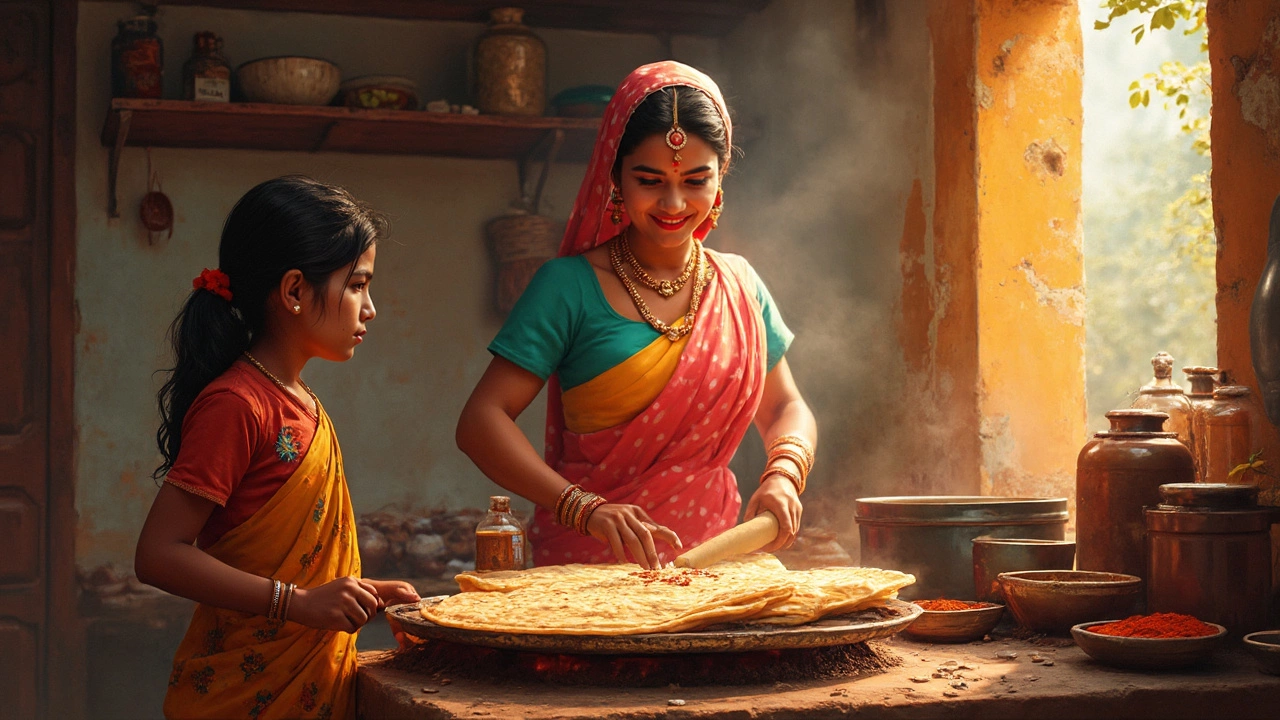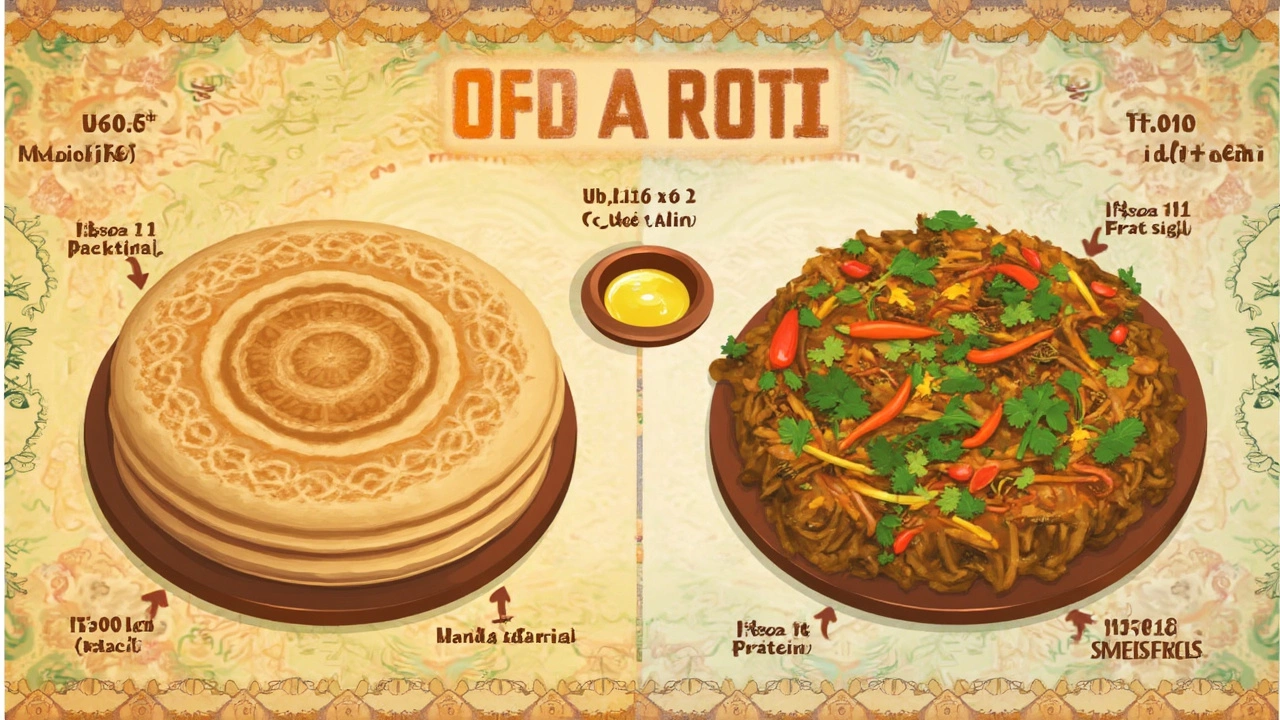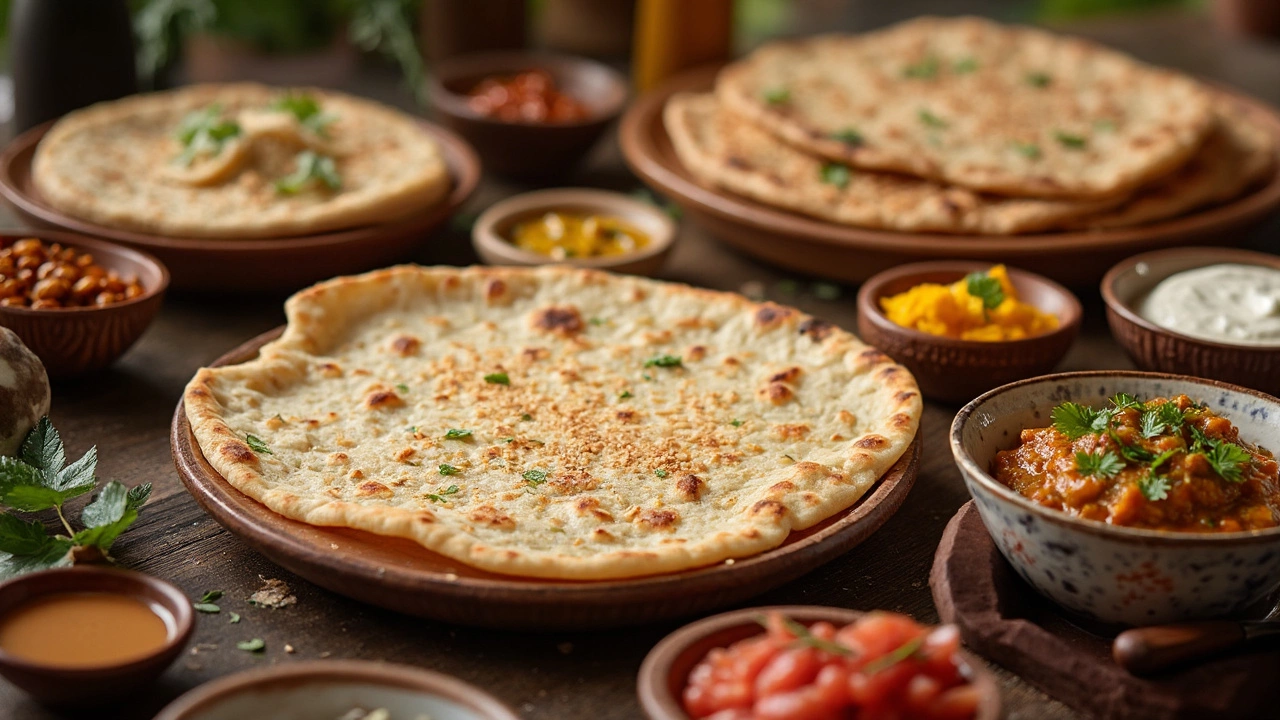Unveiling How Different Cultures Prepare and Enjoy Roti
 Feb, 22 2025
Feb, 22 2025
Roti might seem like a simple flatbread, but it's more than just flour and water. It's a canvas for cultural expression. In India, roti often serves as an everyday bread, while variations find a place in cuisines from Jamaica to Afghanistan. These differences are evident in ingredients, cooking techniques, and how roti complements various dishes.
Making roti isn't just mixing flour and water; it's an art form passed down generations. Each twist of the dough, the way it's kneaded, tells a story of tradition. And whether you slap it on a tawa or bake it in a tandoor, the method affects the final flavor and texture.
Now, let's talk numbers. How many calories in 1 roti? On average, it's about 70 to 100 calories. This number can change based on ingredients and cooking methods. Say you spread some ghee on it—you're adding about 40 more calories. Pair it with a sabzi, and you're looking at a substantial, yet nutritious meal.
Why mess with tradition? Well, knowing the calories in 1 roti and sabzi can help you make informed dietary decisions. It's easier to enjoy this delightful bread when you know what you're consuming, and serve it guilt-free, understanding its nutritional context.
- Roti Around the World
- Preparing the Perfect Roti
- Nutritional Insights
- Cultural Culinary Traditions
- Tips for Enjoying Roti
Roti Around the World
Ever wondered how different corners of the globe interpret the humble roti? This unassuming flatbread adapts to its environment in the most fascinating ways.
The Indian Take
In India, roti is a daily staple. Made from whole wheat flour, or atta, this version is usually rolled out thin and cooked on a hot griddle known as a tawa. It's perfect for scooping up spicy curries and flavorful lentils.
Roti in the Caribbean
In the Caribbean islands like Trinidad and Tobago, roti has taken on a character of its own. Here, it's typically filled with curried meats or vegetables. This adaptation offers a complete meal wrapped in a doughy package.
Middle Eastern Variants
The Middle Eastern equivalent often involves similar ingredients but can include spices and herbs in the dough itself. Paired with dips like hummus or baba ganoush, it's a versatile addition to any meal.
African Interpretations
In East Africa, chapati, which closely resembles Indian roti, is popular. Cooking it involves a bit more oil, resulting in a richer flavor and texture, complemented by stews or beans.
Each of these versions might have different preparation styles but share a common love for roti. So, whether you're enjoying a light Indian roti or a hearty Caribbean wrap, this bread's global journey showcases its universal appeal.
The issue often encountered by roti enthusiasts is replicating the authentic taste and texture at home. A good starting solution is understanding the subtle differences like flour type and cooking techniques specific to each culture. Remember, practice is key when perfecting your roti.
Preparing the Perfect Roti
Ever hear someone say making roti is an art? Well, it really is! But with a few simple steps, anyone can master the creation of this beautiful bread.
Ingredients Matter
Start with the basics: wheat flour, known as atta. It’s important to use flour that’s finely ground and high in gluten to give your roti the right amount of chewiness. Water and a pinch of salt round out the list. For those curious about regional twists, you might even add a teaspoon of oil or ghee for richness.
Mixing and Kneading the Dough
- Mixing: In a bowl, combine 2 cups of atta with a pinch of salt.
- Adding Water: Gradually add about 3/4 cup of water, mixing with your hand until it starts coming together.
- Kneading: Once mixed, knead the dough. This should take about 5-10 minutes. The goal is a soft, pliable dough—not too sticky.
- Resting: Let the dough rest for at least 15-30 minutes. This step is crucial as it allows the gluten to relax.
Time to Roll and Cook
- Dividing and Shaping: After resting, divide the dough into small balls, about the size of a golf ball. Roll them between your palms to smooth out any cracks.
- Rolling Out: Dust a ball with some dry atta, and roll it with a rolling pin. Aim for a circle about 6-7 inches in diameter.
- Cooking: Heat a tawa (griddle) over medium heat. Place your rolled dough on it. When you see small bubbles, flip it over. Keep pressing the sides gently with a cloth or spatula for even cooking.
- Puffing Up: With a little practice, it’ll puff up. Once it puffs, it's done!
Adding Flavor
If you’re interested in exploring flavors beyond plain roti, brushing them with ghee right after cooking adds that irresistible aroma and depth.
| Ingredient | Amount |
|---|---|
| Atta | 2 Cups |
| Water | 3/4 Cup |
| Salt | Pinch |
| Oil/Ghee (optional) | 1 tsp |
With these steps, you're not just making a roti; you're continuing a tradition. Happy roti making! Remember, if at first it doesn’t puff, keep trying. Even the flattest of roti still tastes great!

Nutritional Insights
When you think about it, knowing what goes into your food is more important now than ever. So, let's talk roti. How many calories in 1 roti, right? It's a question many of us consider while enjoying this staple dish.
Caloric Breakdown
The basic roti, made with whole wheat flour, water, and a pinch of salt, generally contains around 70 to 100 calories. Not a bad deal for something so delicious! Now, if you add a dab of ghee, which is often the case, it bumps up by about 40 calories.
Here's a quick rundown:
- Plain roti: 70-100 calories
- Roti with ghee: 110-140 calories
- Roti and sabzi: Depends on the sabzi, but typically totals around 150-300 calories
Why It Matters
So why should you care about these numbers? Well, if you're keeping tabs on your dietary intake, knowing how much calories in 1 roti helps you make better meal decisions. You might swap an extra roti for a salad if you're counting those calories.
Plus, understanding the nutritional density can aid in balancing your macros—those proteins, fats, and carbs. For instance, knowing whether that roti is just pure carbs or also offers some fiber can really help tailor your diet.
Maximizing Nutritional Value
Roti preparation doesn't have to stop at the traditional recipe. You can diversify with multigrains or even add vegetables into the dough! Imagine getting extra fiber from some finely-chopped spinach kneaded right in there.
- Step 1: Start with your usual flour mix.
- Step 2: Add about half a cup of your chosen veggies or grains per 2 cups of flour.
- Step 3: Mix and knead until smooth, then proceed as usual.
Incorporating these tweaks ensures that each roti isn't just filling but also richer in nutrients. That's a win-win!
Cultural Culinary Traditions
Roti has traversed the globe, each culture putting its unique spin on this staple. It's fascinating to see how roti preparation reflects the essence of a community's culinary history, combining local flavors with age-old traditions.
Indian Subcontinent
In India and neighboring countries, roti is made from whole wheat flour, served fresh and soft. It's often paired with a variety of side dishes, from lentils to vegetables, adapting to regional preferences. The crispier, fluffier cousin of roti is the naan, made with leavening agents like yeast or yogurt.
The Caribbean Twist
Jamaican and Trinidadian versions bring a delightful twist. In these cultures, you might find the roti filled with curried meats or vegetables, turning it into something akin to a wrap. This adaptation illustrates how roti has become more than just a side dish—it's a meal on its own!
Middle Eastern Style
Roti in the Middle East, often referred to as 'khubz', shares similarities yet boasts unique flavors. It's traditionally baked in clay ovens, perfect for scooping hummus or baba ganoush, thus playing a crucial role in the meal experience.
A Problem and Solution
One challenge when exploring these diverse types of roti preparations is the availability of ingredients. Fear not, as many ingredients are substitutable. Can't find ghee? Regular butter works just fine. Don’t have a tandoor? A preheated griddle can be surprisingly effective.
How to Enjoy Roti Across Cultures
- Observe: Start by understanding the method of each culture; this helps in appreciating the subtle differences.
- Experiment: Try combining methods from different cultures. How about an Indian-style roti cooked Jamaican-way?
- Balance: When adding extra toppings like ghee, be mindful of the additional calories in 1 roti with ghee. It’s all about enjoying every bite guilt-free.
Taking the time to explore how different cultures prepare and consume roti not only enriches your culinary skills but also connects you to diverse traditions across the globe.

Tips for Enjoying Roti
Roti is versatile, tasty, and can be a joyful addition to any meal. Here are a few tips to elevate your roti-eating experience, whether you're a novice or a seasoned roti lover.
Pair Wisely
Pairing your roti with the right dishes can make or break your meal. Go traditional with some sabzi—it's a classic duo. Ever wondered about the calories in 1 roti and sabzi? Keep it balanced by choosing high-fiber, low-calorie veggies to keep the meal light.
Get Creative with Fillings
Don't just stop at plain roti. Stuff it! From mashed spiced potatoes to paneer, stuffed rotis (or parathas) can be a meal on their own. Feeling adventurous? Try adding international flavors like cheese or olives!
Mind the Layers
Creating layers in your roti, especially when you're using ghee or butter, makes a big difference in texture. Want buttery, flaky bites? Fold your roti into quarters and spread some ghee. Just keep track of calories in 1 roti with ghee if that's a concern.
Keep it Fresh
Roti is best when it's fresh. To keep them soft, wrap them in a clean cloth right off the pan. If you make a big batch, freezing roti with parchment in between layers can be a meal-prep game-changer. Heat it up on a pan before serving for that fresh-from-the-tawa feel.
Experiment with Flours
Yes, whole wheat is the traditional choice, but mixing it up can be fun. Try millet, chickpea, or even spelt flour for an entirely different flavor and nutritional profile—just keep in mind that this might slightly tweak how much calories in 1 roti you'll be munching on.
| Ingredient | Calories Per Serving |
|---|---|
| Plain Roti Flour | 70 |
| Roti with Ghee | 110 |
| Stuffed Roti | 200 |
With these tips, roti can be more than just a side—it can be a culinary adventure on its own. Whether you're counting calories in 1 roti for health goals or exploring global flavors, there's a world of possibilities to enjoy.